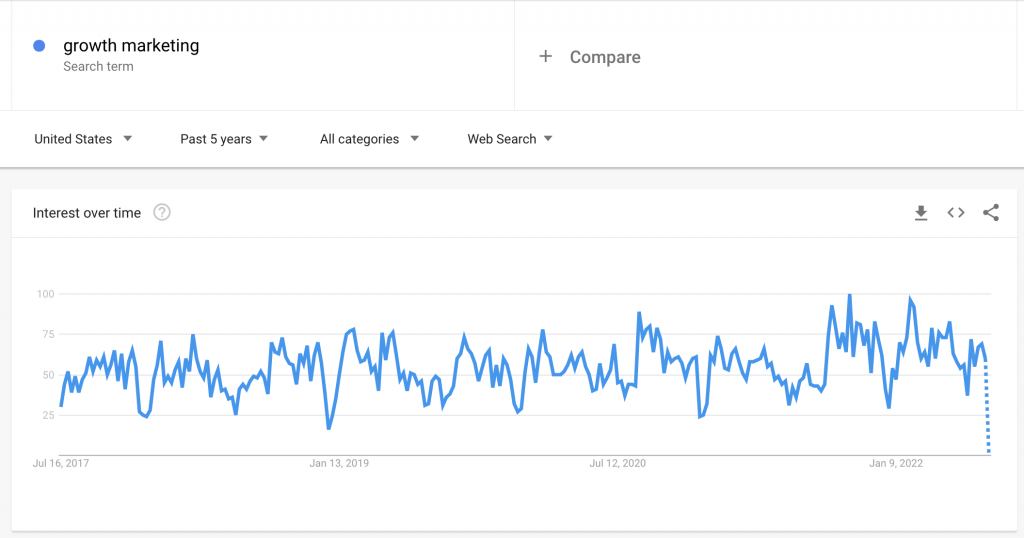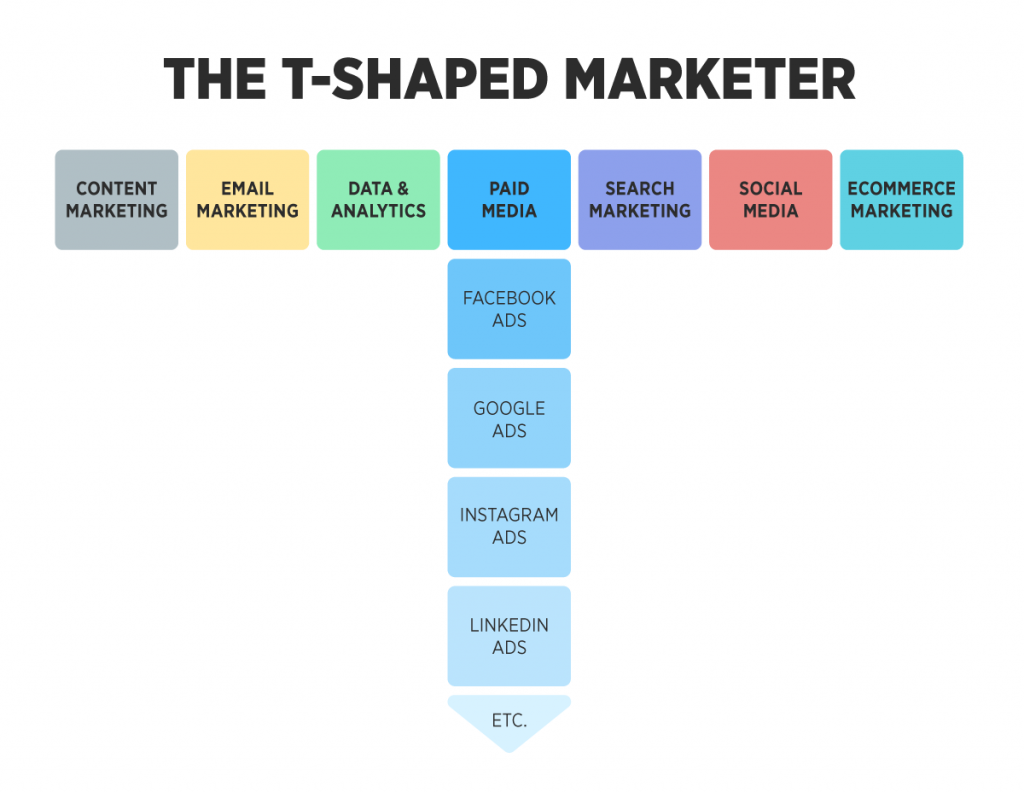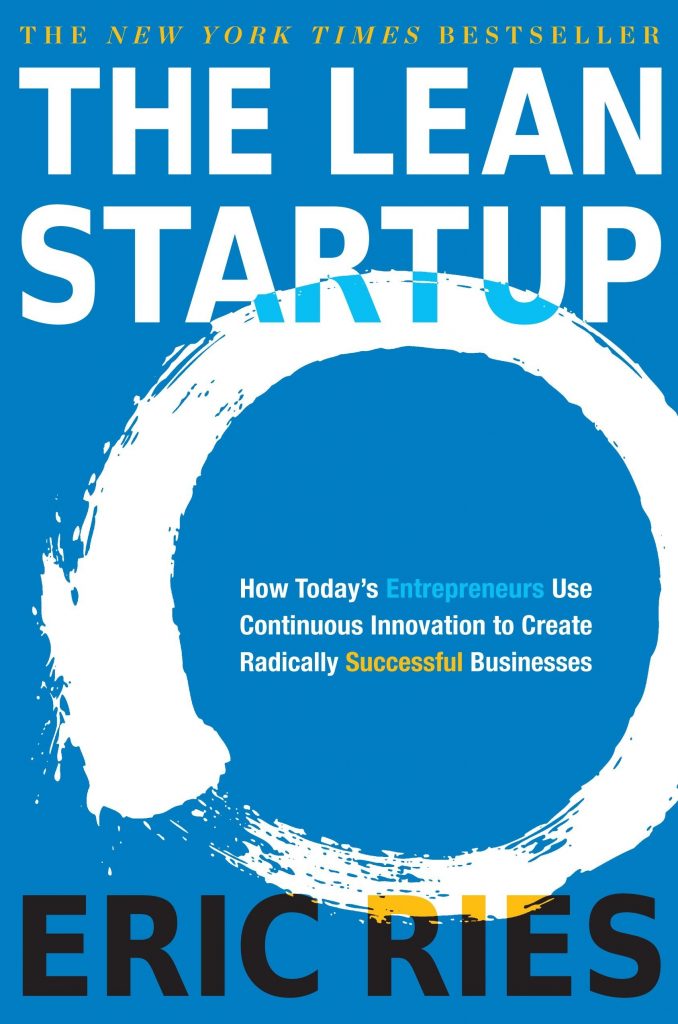- How to Grow a SaaS (Software) Business FAST - February 10, 2025
- 6 Advanced SEO Tips to Dominate the Search Rankings in 2025: Informed by Our Biggest Clients - January 17, 2025
- 7 Advanced Tips for Companies Spending $1M+ on Google Ads - December 10, 2024
“If you don’t have customers, you don’t have much of a business at all…”
That’s what my business partner, Hailey always says. You can have the perfect product, a talented team, and a high customer lifetime value, and still have no business.
That’s where growth marketing comes in. Growth marketing is intelligent, data-driven marketing, with which the aim is to acquire more customers.
No cutesy brand awareness campaigns; nothing but lead generation and revenue growth.
Table of Contents
Why is growth marketing so popular these days?
Growth marketing is an increasingly in-demand skill across a wide variety of businesses. As of today, there are 75,209 “growth marketing” jobs posted on LinkedIn (in the U.S. alone!).

And search interest for “growth marketing” has risen by over 100% in the last 5 years according to Google Trends.

But why?
The answer is simple: Small businesses and large corporations alike have to grow. Whether it’s to put food on the table or allay shareholders concerns, growth is a necessary component of any successful business operation.
A great growth marketer can help businesses grow. Great growth marketers define customer segments and find cost-effective customer acquisition channels. They can also solidify a growth strategy to set a business up for success 2-5 years down the road.
Growth marketers may specialize in some or all parts of the marketing funnel. And they can commonly execute against strategies as varied as…
- paid marketing
- email marketing
- product-led growth
- referral/affiliate marketing
- SEO
- data and product analytics
- and more.
That’s a lot of stuff!
Like I said, there is definite specialization within growth marketing. A good growth marketer has enough breadth of experience to identify impactful marketing levers — and enough depth of experience really pull those levers and drive growth. I’ve heard this “narrow, then deep” approach called a “T-shaped marketer.”

And finally, all of a growth marketer’s hypotheses, experiments and executions must be informed by data. In my opinion, a data-driven growth mindset is a must.
I was the Head of Marketing for three technology companies in San Francisco: RealtyShares, PlushCare, and Minted. At each of them, growth marketing was a little unique, but here’s what I learned…
What is growth marketing?
Growth marketers differ from Don Draper in that they focus on the entire customer funnel, not just the top of funnel.
In the days of Mad Men, once the creative message, copy and campaign were presented to the board of directors, a marketer could wipe his or her hands clean and make a cocktail.

Growth marketers are constantly tinkering with ads, tweaking webpages and testing hypotheses, all in the name of increasing dollars generated by any means possible.
To put a finer point on it, these are the five facets that separate a growth marketer from a traditional marketer:
- Small experiments: Growth marketers understand that big growth wins come from small experiments. The best growth marketers have a toolkit of growth tactics like SEO, affiliate marketing, PPC ads, email marketing, product tweaks and more. A savvy marketer will order experiments based on certainty, scalability, and ease of execution to iterate and arrive at needle-moving tactics.
- Full funnel: The job title “lead generation” and “acquisition marketing” have fallen out of favor a bit in the last couple years. That’s because both of those disciplines only focus on the top of funnel. A growth marketer should be able to both acquire leads and understand how to nurture those leads down to the point of conversion and increase the value of those customers over time.
- Product marketing: While not the exact job title, product marketing is an important step in acquiring customers. Without understanding your target customer’s desires and the messaging necessary to convert them, a growth marketer cannot be effective. That’s why I always start any new growth role with about 15 phone calls to customers.
- Technical skills: A good growth marketer knows how to operate in the key ad platforms like Google and Facebook. Moreover, they should have at least a rudimentary understanding of coding, so that they can work with product and engineering teams to place advertising pixels, make site changes for SEO, or to run an A/B test.
- Speed: Personally, I don’t think anyone can be effective at a growth role at a venture scale company without speed. It takes a certain amount of horsepower to run through the experiments and execute on a full suite of tactics to drive growth.
Where did “growth marketing” come from?
1. I imagine the term growth marketing was officially born out of Eric Ries’ book, The Lean Startup. That being said, the concept of growth marketing was around much before the book was published in 2011.

The Lean Startup teaches entrepreneurs to:
- Be hyper-efficient with resources in order to make the most viable business decisions.
- Run small experiments all the time. Even though 9 out of 10 experiments may fail, the one that succeeds may make your business grow 100x faster.
- Learn and react to the customers’ behaviors constantly, iterating to make sure that you are always marketing in the most effective way possible.
For example, if you’ve decided to sell one widget in 2017, why not make three different widgets to sell in January and then sell the best performing widget for the subsequent 11 months? The growth marketer plays a crucial role in the lean startup process by constantly testing and tweaking to make the business grow as fast as possible.
2. Venture capital has probably also accelerated the necessity of growth marketing. Allow me to explain:
- Most venture capital funds have about a ten year fund life.
- This means is that a venture capital firm must source, vet and invest in good companies and those same companies must have a liquidity event within ten years or the fund will not be able to return capital to its limited partners.
- With this timer on venture-backed startups, companies must accelerate growth at all cost.
3. Growth marketing is data driven. Growth marketers are obsessively focused on data.
The best marketers use data in their understanding and acquiring of customers. At small and large companies alike, the board room is becoming increasingly data driven. Data gives operators an edge up on their competition and some of the best data is customer data.
Using:
- Funnel analyses,
- A/B testing,
- Surveys,
- And other experimentation,
Growth marketers are harvesting valuable information that can drive decision-making on the highest level.
4. Growth marketing can be extremely cash efficient.
At most companies, a marketer is given a budget (quarterly or yearly) and is expected to acquire as many users or customers as possible with that cash. If you look at some of the best growth hacking examples, they often take little budget to make work.
Take for instance, the infamous Dropbox referral program growth hack:
- They offered customer referral bonuses of 16GB of storage space for each person they referred to dropbox.
- Dropbox was able to grow from 100,000 customers to 4,000,000 customers in just 15 months.
- How much did all that customer acquisition cost? The price of 32GB of storage space (16GB for the referrer and 16GB for the referee), which I’d estimate costs Dropbox a couple of cents.

5. Marketers have heard stories of incredible success with growth marketing.
Nerdwallet, Genius (formerly RapGenius), Dropbox, PayPal, Facebook, Mint and many more have growth hacking to thank, at least in part, for the incredible success they have had.

What are some growth marketing best practices?
1. Stay current
Part of the nature of growth marketing is understanding trends in the industry and uncovering new tactics or ad units to take advantage of growth opportunities.
How might you do this? Follow a couple of blogs on the topic (like this one). Also The Kissmetrics blog and Quicksprout blog are well written and cover a bunch of growth marketing tactics.
Staying current is important. There are techniques that worked a few years ago but don’t work well today and there are plenty of examples of brand new channels with high ROI. Fab’s “invite only” launch was a great way to force virality early on, but people have become more weary of giving away their email address in similar ways today.
2. Collect emails, social signups and shares.
Growth marketing works best when there is “free” communication with users and potential users. Once you have a user’s email address or they sign up through a social channel for your website, you have their attention (sort of) and anything you publish is more likely to get in front of them for free. Don’t pay to acquire the same customer twice!
Read: 10 Ways to Capture Email Leads
3. Create strong content.
No matter what you’re doing or selling online, internet users demand quality. Consumers see news and blogs every day. CBS News claims we see ~5,000 ads per week and we see plenty of garbage.
You will only succeed online with great content. This can come in the form of great blogging, excellent photography if you have an ecommerce business or a great piece of software if you’re selling a Saas product. Be customer-centric and make something great for others to share and consume.
4. Focus narrowly.
The internet is crowded. In addition to creating strong content, don’t try and do everything.
Said again, the internet is enormous! If Chubbies Shorts and Cards Against Humanity can make millions of dollars selling shorts and a silly card game, you can make millions doing whatever it is you’re doing.
When you focus narrowly, you become an expert in a field and people will associate you or your website with that service or product. When a customer or user has an association vector for your brand or service, your cost to acquire and reengage them is much lower. For some ridiculous ideas that have made millions see here.
5. Proof.
Do you have any doubt that your order on Amazon.com will arrive at your home within a few days? We all have proof that Amazon is who it says it is — from sweeping news coverage and our own experiences ordering from Amazon. I have every reason to believe that the package I order today on Amazon will arrive in the next few days.
So unless you’re Amazon, The New York Times, Google or some other huge brand, nobody has any reason to believe your website is the real deal.
Use media proof, social proof and testimonies of customers to create a strong brand and increase your trust factor.
You can even use a tool called Proof to show visitors proof that other people have taken action and made purchases on your site.
6. Think creatively.
There isn’t ONE growth marketing playbook. The nuances of every business are different and tactics have very different efficacy across industries and over time. Even great ideas fatigue eventually. Consumer sentiment may change or competitors begin to mimic tactics that work well, which drives up cost by virtue of steeper competition.
The first mover will always have the advantage when it comes to growth. The good news is that thinking intelligently about growth is more important than thinking creatively. There are certain frameworks for thinking about growth that will make you more acute at spotting opportunities for growth. We love thinking creatively here at Growth Marketing Pro– watch how we do it here.
When should I hire a growth marketer?
As you think through bringing on a growth marketer, consider these two things:
- Growth marketers are a key part of growth, but they cannot solve poor product-market fit. I hate to say it, but some businesses cannot grow. Simply, if you don’t have product-market fit yet, a growth marketer will not be able to solve that for you. Sure, they might be able to get leads in the top of funnel and even drive revenue, but they will not be able to build a sustainable, viable business without a product that works.
- Can you afford one? The average growth marketer makes $85k per year. Plus, if you want one to be effective, you need to set aside budget for them to test channels. Unfortunately, marketing isn’t cheap. In order to perform, a growth marketer will need a small budget to run ads, create content, generate leads, etc.
Conclusion
Growth marketing is not a cure-all. There’s no Uber, Airbnb, Facebook, Amazon, or Nike without an incredible product that fills a market void. But growth marketing can accelerate growth. A good growth marketer will run enough experiments and understand data well enough to uncover tactics that will move the needle for your business.
Also read:




